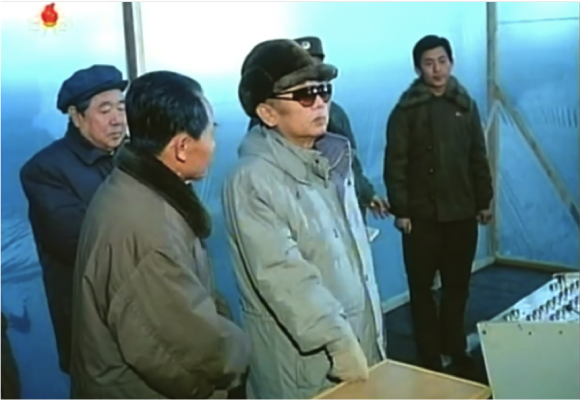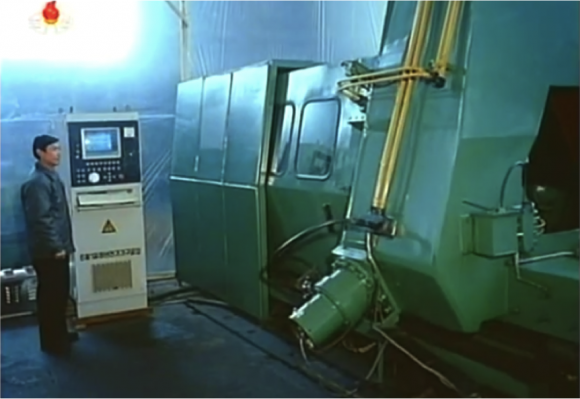Yet another flow-forming machine has appeared on North Korean television. (Here are the earlier ones.) This one is shown being exhibited to Kim Jong-il, late in his life by the look of him.
If you’re coming late to this story, a flow-forming machine (or flow-forming lathe) is a specialized machine tool. It has a handful of uses, but among them is forming the maraging-steel rotors that experts believe are used in North Korea’s gas centrifuges. Since gas centrifuges are used to enrich uranium, that makes flow-forming technology pretty interesting in these parts.
It’s unclear where this display took place; other than the floor, the location is obscured by a tent of translucent plastic sheeting. Was it placed there to shield the machine from onlookers? To shield the location from the camera accompanying Kim Jong-il? To keep the machine clean or help regulate its temperature during operation? Or perhaps some other reason? It’s hard to say.
Above, we see KJI in front of a control panel, gazing at something while an official gives an explanation. Now, here’s what he was gazing at:
This machine appears similar to the one Kim Jong-un viewed in 2013, but is not identical.
* * *
The presence of a variety of flow-forming machines inside North Korea is no longer any kind of news. Scott Kemp identified one shown to Kim Jong-il at the Kusong Machine Tool Plant in September 2006, and another shown to Kim Jong-un at the Kanggye “Tractor Factory” in June 2013. Jeffrey Lewis and Amber Lee put this development in the context of North Korea’s efforts to produce CNC machine tools at home. Yours truly identified at least three generations of flow-forming machines inside North Korea. David Albright and Olli Heinonen confirmed the identification, while observing that we don’t know where all of the machines were made. (I continue to suspect that the machine shown at Kusong may have been a prototype produced there. Of course, when it comes to making centrifuge rotors, where the flow-forming machines might have been built is beside the point.)
The bottom line remains the same: despite the best efforts of the international community, North Korea has gained access to some very interesting, sensitive technology. We knew that already, but now perhaps we know it just a little moreso.



Flow-forming machines are useful for all sorts of things besides forming maraging steel centrifuge rotors. Things like compressed gas cylinders and hydraulic cylinders and the like that are pretty benign.
Of course, the rapt attention by two generations of Kims makes it pretty unlikely that they are making gas cylinders or hydraulic parts. Guilt by association, I know, but they had to be taking time off from snuffing their uncles to show up in some industrial plant somewhere. On the other hand, it is just a component and something that would not be picked correctly out of a lineup by anyone other than an arms control wonk or a weapons grade physicist or engineer. It is all quite odd…
Most of the machines we’ve seen seem to have been of North Korean manufacture. Perhaps they bought a used one and reverse engineered it or perhaps even designed their own based on a knowledge of what it needed to do.
People build home-made CNC mills capable of excellent precision all the time. While a full sized machine such as this is an order of magnitude greater, it’s probably well within the reach of a university engineering department.
I’m really not sure why we think that the couldn’t do something on their own when we’ve been doing it industrially for half a century.
I dunno about that. My last entry in the old thread was a YouTube video from a manufacturer, where one of the machines was an awfully good match for the machine under discussion. I didn’t press about the match for fear that the manufacturer or the moderater might not like the match.
Hmm. You mean the Denn-RL-600-CNC? The control panel is very interesting. But the carriage has a very different look. Or am I comparing the wrong images?
You’re looking at the right image. Looking carefully now I realize the RL-600-CNC is a much larger machine, maybe newer. At the time I was focusing on the design/styling of the control pulpit and the cabinets. I had sat here looking at dozens of YouTube promos and company websites for flow-formers. The cabinet window, the overall shape of the cabinet, the grated gutters along the sides. I didn’t see any other manufacturer’s style that was even close. Now I see more of the differences; but I’d still like to call the style detail a match.
I realize engineers especially tend to think form follows function, but industrial designs are distinctive enough they can often be used to make a case for copying; not what I think I see.
Interesting observations. Here’s a timely blog post on India-DPRK trade: http://blogs.piie.com/nk/?p=12892
Wait. A clarification is necessary here. Denn is Spanish, not Indian.
I am waiting to see a North Korean 3D printer on the horizon.
I don’t believe international communities are against NoKor from obtaining CNC machine technology. Of course there are handful of nations that are against NoKor from obtaining such tech, but they don’t represent “international community”. There simply are more nations around the world that stay neutral or supportive of NoKor than what politicians and media would like to present.